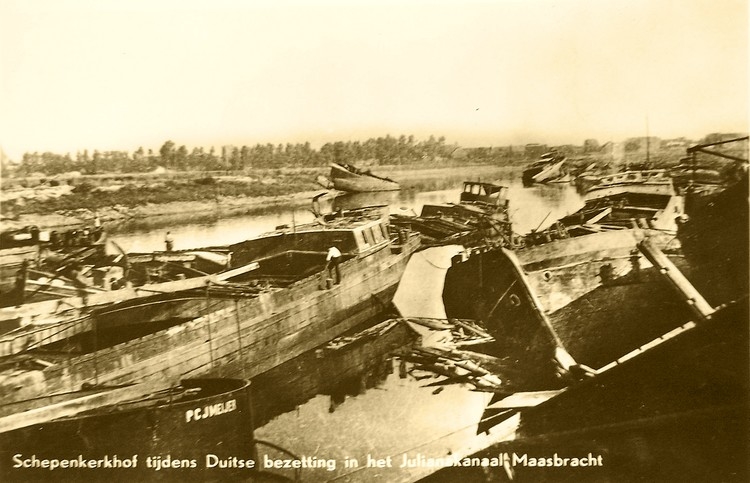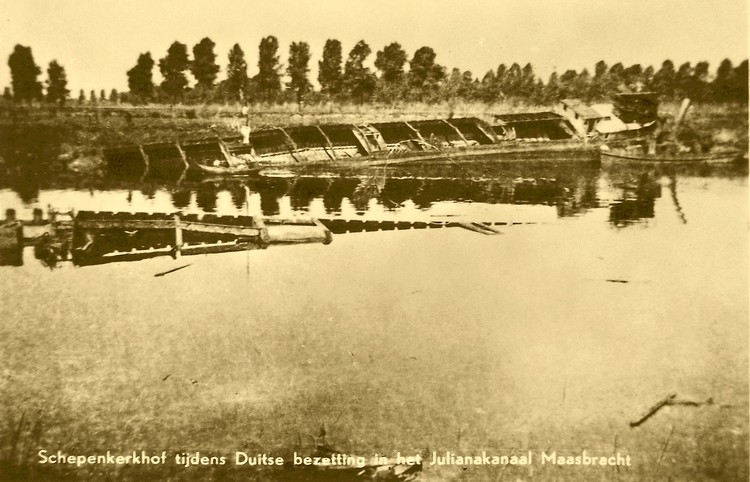During WWII, massive damage was done to infrastructure. Many measures were taken to get important goods from point A to point B. Therefore, wherever possible, inland navigation continued throughout the war.
Maasbracht was the most important port in the Juliana Canal, with a direct connection to several important waterways. The town was always bustling with boatmen, and their families.
In 1942 the ship ‚Rheinlust‘, carrying coal, rammed the northern door of the Maasbracht locks. All the water between Maasbracht and Roosteren came crashing down the damaged doors at once, dragging several ships along, killing a number of people on board. Although this was not a sabotage action, the locks could no longer be used at their full capacity.

Along with the coalship 'Rheinlust', the thugboat 'Amiko' was dragged out of the locks by the enormous floodwave. The ship 'Slamat' (picture) got stuck on the ramp of the lock and broke in half
Over 2 years later, in September 1944, the remaining lock had a severe malfunction. As a result, there were no less than 240 ships at the port, waiting until they could continue their journey southwards.
In the end of September, the allied forces were closing in on the Germans. Most of southern Limburg had already been liberated and US forces were heading north rapidly.
On 29 September the German command ordered all the ships to be cleared. Two ships loaded with cement were scuttled at the entrance of the port, so no other ships could leave. Many boatmen and their families would have been forced to live in the streets, if it weren’t for the inhabitants of Maasbracht, who lovingly took the homeless families in.
One day afterwards, one by one the ships were rigged with explosives and sunk. According to the Germans this was ‘necessary to prevent the enemy from using the materials against the Reich’. Many men stood on the quayside and watched how the ships were destroyed. With it, not only their sole source of income sank to the bottom, but also their home, all of their belongings and part of their life.


Because of fierce German resistance it took the US Army another 2 months before they could advance towards Maasbracht. The German command ordered all of the village to be evacuated. Many people resisted. They didn’t like the idea of being moved further into Nazi-occupied territory whilst liberation was only days away. They preferred waiting for the Americans. Some people were taken from their homes in a rather violent way. People who cooperated were taken to Montfort, at a short distance from Maasbracht. Troublemakers and their families were taken to Friesland, in the northernmost part of the Netherlands.
The people who were taken to Montfort only had to wait a few days until they were liberated. Sadly, many of them died when the Germans started an artillery barrage from across the border.
The people who were in Friesland had to wait another six months for liberation. Many of them perished during the ‘hongerwinter’, the extremely cold winter of ’44-’45, when there was severe shortage of food and fuel in the occupied north of the Netherlands.
Immediately after the liberation of Maasbracht, the allies started clearing the port. It took until July 1945 to get all the ships out of the water.
The monument was revealed in 2004, excactly 70 years later. In the nearby Navigation Museum there is a permanent exposition dedicated to the tragic event.
This cache is part of a series. The caches are:
'40-'45: Kapelaan Berix (GC2PEZJ) (in English) '40-'45: Veer Berg-Meeswijk (GC2PEXA) (in English) '40-'45: Brug Obbicht (GC2PER6) (in English) '40-'45: Sluis Born (GC2PEP0) (in English) ’40-’45: Brug Roosteren (GC2TV5X) (in English) '40-'45: Sittard War Cemetery (GC2TV9R) (in English) '40-'45: Staff Sergeant Booher (GC2TQC1) (in English) '40-'45: Jürgen G. Krohnke (GC2X5V3) (in English) '40-'45: RCAF Bomber Crew (GC2X60A) (in English) '40-'45: Schepenkerkhof (GC2X6KF)All caches contain a bonus number. When you find all 10 of them, you can search for the bonus cache (GC2X6MV).
Did you find one or more caches in the series before there were bonus numbers added? Send me a message,telling which caches you’ve found and on which date. I will try to send you the bonus numbers as soon as possible!
Hint:
Name + 20cm
Geen opmerkingen:
Een reactie posten